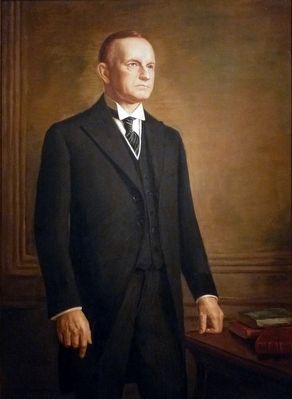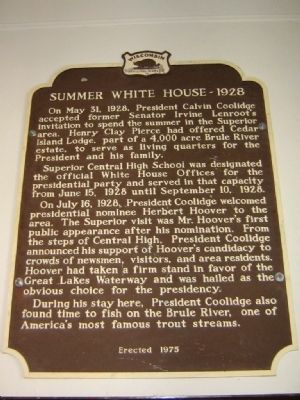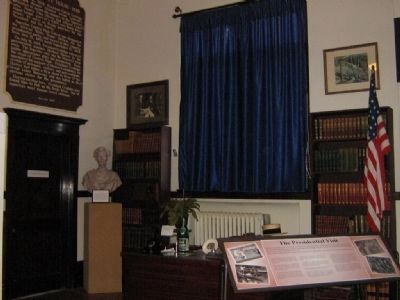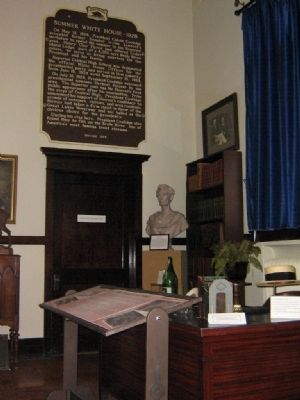Superior in Douglas County, Wisconsin — The American Midwest (Great Lakes)
Summer White House - 1928
On May 31, 1928, President Calvin Coolidge accepted former Senator Irvine Lenroot's invitation to spend the summer in the Superior area. Henry Clay Pierce had offered Cedar Island Lodge, part of a 4,000 acre Brule River estate, to serve as living quarters for the President and his family.
Superior Central High School was designated the official White House Offices for the presidential party and served in that capacity from June 15, 1928 until September 10, 1928.
On July 16, 1928, President Coolidge welcomed presidential nominee Herbert Hoover to the area. The Superior visit was Mr. Hoover's first public appearance after his nomination. From the steps of Central High, President Coolidge announced his support of Hoover's candidacy to crowds of newsmen, visitors, and area residents. Hoover had taken a firm stand in favor of the Great Lakes Waterway and was hailed as the obvious choice for the presidency.
During his stay here, President Coolidge also found time to fish on the Brule River, one of America's most famous trout streams.
Erected 1975 by Wisconsin Historical Society. (Marker Number 213.)
Topics and series. This historical marker is listed in this topic list: Government & Politics. In addition, it is included in the Former U.S. Presidents: #30 Calvin Coolidge, the Former U.S. Presidents: #31 Herbert Hoover, and the Wisconsin Historical Society series lists. A significant historical month for this entry is May 1751.
Location. 46° 43.515′ N, 92° 6.073′ W. Marker is in Superior, Wisconsin, in Douglas County. Marker can be reached from the intersection of John Avenue and North 11th Street. The marker is on display in the Coolidge Exhibit at the Douglas County Historical Society. Pictures provided by DCHS. Touch for map. Marker is at or near this postal address: 1101 John Ave, Superior WI 54880, United States of America. Touch for directions.
Other nearby markers. At least 8 other markers are within 4 miles of this marker, measured as the crow flies. The University of Wisconsin-Superior (approx. 0.8 miles away); Wartime Shipbuilding (approx. 1½ miles away); S.S. Meteor (approx. 1.8 miles away); Duluth-Superior Harbor (approx. 2½ miles away); Old Stockade Site (approx. 2½ miles away); Rice's Point (approx. 3½ miles away in Minnesota); Oneota (approx. 3.6 miles away in Minnesota); Enger Observation Tower (approx. 3.7 miles away in Minnesota). Touch for a list and map of all markers in Superior.
More about this marker. This marker was originally located in front of Superior Central High School, 1015 Belknap St. The school was demolished in 2004, despite preservation attempts. The marker was moved to the Douglas County Historical Society.
Also see . . . Douglas County Historical Society. (Submitted on February 21, 2012, by Bernard Fisher of Richmond, Virginia.)

Photographed By Allen C. Browne, August 9, 2015
4. Calvin Coolidge
This 1956 portrait of Calvin Coolidge by Joseph E. Burgess (after Ercole Cartotto) hangs in the National Portrait Gallery in Washington, DC.
“Americans expect their presidents to be active, which explains why Calvin Coolidge has been labeled by historians as the ‘quiet president’ and an ‘American enigma.’ Coolidge was propelled to national prominence, and the vice presidency, by his decision, while governor of Massachusetts, to fire striking officers in Boston's police strike of 1919, proclaiming, ’there is no right to strike against the public safety by anybody, anywhere, any time.’ Assuming the presidency after Warren Harding's death in 1923, Coolidge determined not to do anything to upset American prosperity. Upon election to the presidency, Coolidge, in his 1925 inaugural address the first on radio expressed his belief that ‘the people of America [should] … work less for the government and more for themselves.… That is the chief meaning of freedom.’ When Coolidge left office, political commentator Walter Lippmann wrote, ‘Surely no one will write of those years … that an aggressive president altered the destiny of the Republic. Yet … no one will write … that the Republic wished its destiny to be altered.’” — National Portrait Gallery
“Americans expect their presidents to be active, which explains why Calvin Coolidge has been labeled by historians as the ‘quiet president’ and an ‘American enigma.’ Coolidge was propelled to national prominence, and the vice presidency, by his decision, while governor of Massachusetts, to fire striking officers in Boston's police strike of 1919, proclaiming, ’there is no right to strike against the public safety by anybody, anywhere, any time.’ Assuming the presidency after Warren Harding's death in 1923, Coolidge determined not to do anything to upset American prosperity. Upon election to the presidency, Coolidge, in his 1925 inaugural address the first on radio expressed his belief that ‘the people of America [should] … work less for the government and more for themselves.… That is the chief meaning of freedom.’ When Coolidge left office, political commentator Walter Lippmann wrote, ‘Surely no one will write of those years … that an aggressive president altered the destiny of the Republic. Yet … no one will write … that the Republic wished its destiny to be altered.’” — National Portrait Gallery
Credits. This page was last revised on July 31, 2020. It was originally submitted on February 2, 2012, by Eric Kuntz of Beaver Dam, Wisconsin. This page has been viewed 2,969 times since then and 148 times this year. Photos: 1, 2, 3. submitted on February 20, 2012, by Eric Kuntz of Beaver Dam, Wisconsin. 4. submitted on October 17, 2015, by Allen C. Browne of Silver Spring, Maryland. • Bernard Fisher was the editor who published this page.


